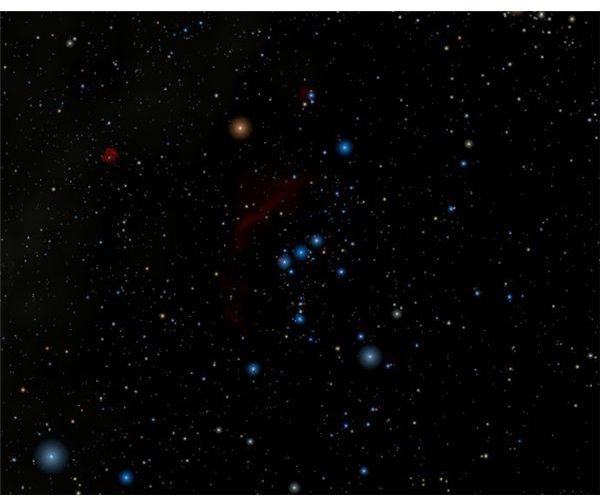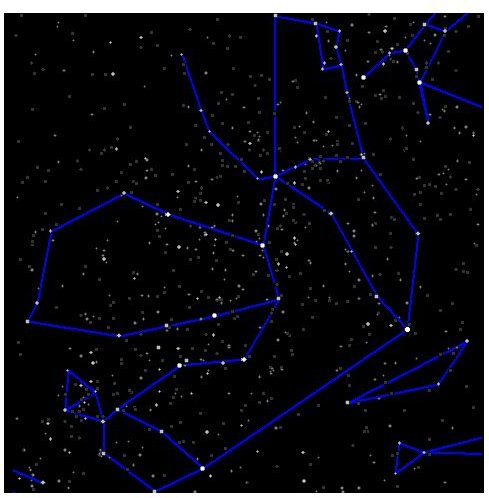The Light Fantastic: Constellations of the Night Sky
Types of Constellations
The International Astronomical Union recognizes 88 constellations. Half of them were named by the ancients. Scientists of the renaissance added even more constellations, sometimes jumbling them up with ones the ancient astronomers had described. The astronomer Jakob Bartsch invented the constellation Crux, or the cross, by appropriating four stars from its neighbor, the constellation Centaurus. By 1930, the IAU had simplified the constellations into regions, many with zig zag borders so that they didn’t interfere with each other. For example, stars that used to be in the constellation Pegasus are now in Andromeda.
Constellations in astronomy are often divided into three groups: constellations of the Zodiac, constellations described by Ptolemy, and constellations added after 1600.
The Constellations of the Zodiac
The constellations of the Zodiac follow the ecliptic, or the path of the Sun, across the sky.
Aries, the Ram. This is the ram whose golden fleece was stolen by Jason of the Argonauts.
Taurus, the Bull. This is the bull Zeus turned himself into when he kidnapped Europa, another one in his endless list of mortal and semi-divine amours.
Gemini, The Twins. These are Castor and Pollux, the brothers of Helen of Troy.
Cancer, the Crab. One of Hercules’ Twelve Labors was to defeat the Hydra. The goddess Juno, who never liked Hercules since he was one of Zeus’ countless outside children, sent a giant crab to attack Hercules. Hercules of course crushed it, but Juno rewarded her crab by putting him among the stars.
Leo, the Lion. The defeat of this Lion was another of Hercules’ Labors.
Virgo, the Virgin. No one can say for sure who this constellation is based on. She might have been based on the goddess Ceres, even though Ceres wasn’t a virgin. Folklorists suspect Ceres, because the constellation’s brightest star, Spica, represents an ear of wheat or corn.
Libra, the Scales. Libra was probably once part of the constellation Scorpius, because its two brightest stars mean “the southern and northern claw.” Now, Libra is associated with the Goddess of Justice.
Scorpius, the Scorpion. The god Apollo was worried about the hunter Orion’s designs on his sister Artemis, so he set this scorpion on him. Orion and the Scorpion were placed as far away from each other in the sky as they could be, but the Scorpion eternally pursues him.
Sagittarius, the Archer. This is the centaur Chiron, who was also an archer.
Capricorn, the Sea Goat. This goat is placed in an area of the sky ancient astronomers called The Sea. It’s often depicted with the front half of its body as a goat and the back half as a fish.
Aquarius, the Water Carrier. This is a man pouring water from a bucket, which symbolizes the rainy season.
Pisces, the Fish. To escape the monster Typhon, Venus and Cupid disguised themselves as these fish and jumped into the Euphrates River.
Ptolymaic Constellations

These are based on more stories of gods, goddesses and their allies and enemies. Andromeda was a princess who was chained to a rock to provide a meal for a sea monster, who was slain by Perseus. Aquila was an eagle who bore the mortal boy Ganymede to Olympus to be the gods’ cup bearer. Ara is the altar the Olympic gods raised to celebrate their victory over the Titans. Argo Navis was the ship of Jason and the Argonauts. No one’s quite sure about the stories behind Auriga, the charioteer, or Boötes the Herdsman.
Canis Major is one of Orion’s dogs. Canis Minor, the lesser dog, is Helen of Troy’s favorite dog, who refused to bark when Paris came to abduct her. Cassiopeia is the mother of Andromeda, while Cepheus is her father. Centaurus, the centaur, is also associated with Chiron. Cetus is the whale or sea monster who wished to devour Andromeda. Corona Australis, the Southern Crown, is the crown of laurel or olive placed on the head of the victor of the games. On the other hand, the Corona Borealis, the Northern Crown, was given to the princess Ariadne by Dionysus.
Corvus is a raven tasked by Apollo to keep an eye on one of his many lovers. When she cheated on him, the raven told Apollo, and Apollo rewarded him by putting him in the sky.
Crater, the Cup, is associated with many gods and goddesses, including Apollo and Bacchus.
Cygnus, the Swan, was the friend of Phaeton, the mortal who took charge of the chariot of his father, the god Helios. Phaeton couldn’t control the chariot and Zeus had to destroy him with a thunderbolt. His friend, Cygnus, dived into the river to search for his body. Apollo felt sorry for Cygnus, changed him into a swan, and placed him in the sky.
Delphinus, the dolphin, persuaded a sea goddess to marry Poseidon, and Poseidon placed him in the sky.
Draco, the Dragon, was slain by Cadmus. Later, the dragon’s teeth were sown into the ground. They rose up as armed men who helped Cadmus build the city of Thebes.
Equuleus, the Little Horse, is the brother of Pegasus.
Eridanus, the River, is a very long constellation said to steam eternally because of Phaeton’s fall into it.
<strong>Hercules</strong> is the most famous and tragic of all the Greek heroes. He performed the Twelve Labors.
Hydra was a many headed monster that Hercules had to defeat.
Lepus, the Hare, was placed in the heavens as a reward to its hunter, Orion, who of course will never catch him.
Lupus the Wolf used to be a human king who tried to serve Zeus the flesh of a child. Zeus was so disgusted he changed teh king into a wolf, but for some reason put him in the heavens as well.
Lyra, the Lyre, is the instrument Apollo gave to Orpheus, the most accomplished musician in ancient Greece.
Ophiuchus is the Serpent-Bearer and is associated with Asclepius. He was the first surgeon, and was so good at his work that Pluto, god of the underworld, began to worry that Hades would be depopulated. He persuaded his brother Zeus to strike Asclepius, but to put him among the stars. The serpent twined around a staff is his symbol.
Orion is the hunter who tried to woo Artemis, Apollo’s sister. Apollo was worried about Artemis’ virtue, and tricked her into killing him. She put Orion among the stars.
Pegasus is the winged horse that sprang from the blood of the severed head of Medusa. Pegasus became a constellation on his own, flying up into the heavens.
Perseus was the hero who killed Medusa. She was so terrible to behold that she turned men to stone, so he used his shield as a mirror to avoid looking directly at he as he beheaded her.
Pisces Austrinus is the monster Typhon, who came to attack the Olympians.
Sagitta, the arrow, has been associated with several different beings, include the Cyclops.
Serpens, the serpent, is associated with Ophiuchus.
Triangulum is a small constellation whose shape, the delta, is associated with the Delta of the Nile River.
Ursa Major, the Great Bear, was Callisto, another one of Zeus’ paramours. Artemis changed her into a bear because she had given up her virginity, or perhaps Zeus changed her to save her from the wrath of his wife Hera, or maybe Hera changed Callisto herself. Ursa Minor is Callisto’s son by Zeus.
Constellations Since 1600

The constellations in astronomy added since 1600 are creations of the Renaissance, and the Age of Enlightenment and Discovery. Several of them are machines or instruments, and a few reflect a certain lack of knowledge. Thanks to the ability of European astronomers and scientists to embark on long sea voyages, nearly all of them are in the southern hemisphere.
Antila is a Pump. Apus is the Bird of Paradise. Apus means “without foot,” because the astronomers who named this constellation thought that Birds of Paradise lacked feet.
Caelum, the Chisel, is made up of stars stolen from Columba and Eridanus. Camelopardalis is the Giraffe. This constellation was named because it was supposed to be the camel that brought Rebecca to Isaac. But it’s a giraffe.
Canes Venatici, the Hunting Dogs, are the dogs of Boötes.
Carina is the Keel of the ship Argo, while Chamaeleon is a chameleon.
Circinus is the drawing compass that sits south of Lupus, and Columba is the Dove. Petrus Plancius, a theologian and mapmaker from Holland, named this constellation after the dove Noah released from the ark.
Coma Berenices was named by the great astronomer Tycho Brahe. Berenice promised to sacrifice her hair to Venus if her husband returned safely from the wars. He did.
Crux, the cross, looks like a kite, as it has no central star.
Dorado, the Swordfish, is the home of the Large Magellanic Cloud.
Fornax, the Furnace, is in the southern bend of Eridanus.
Grus, the Crane, is also in the south, as is Horologium, the Clock. Hydrus the Water Snake isn’t the same as Hercules’ Hydra.
Indus, the Indian, is supposed to represent a Native American, and holds arrows in both his hands.
Lacerta, the Lizard, was created out of random stars between Cygnus and Andromeda, and Leo Minor was formed out of stars between Leo and Ursa Major.
Lynx was discovered by the astronomer Hevelius, who claimed that only people with eyes sharp as a lynx’s could see this constellation.
Mensa, the Table, was named after Table Mountain in South Africa.
Microscopium is the Microscope, Monoceros is the Unicorn, Musca is the Fly. This constellation is also called the Bee.
Norma is the Square, while Octans is the Octant, which celebrates John Hadley’s 1730 invention of this instrument.
Pavo is the Peacock, and it’s one of the few of these “new” constellations that was named after an ancient myth. Argos, the builder of the ship Argo, was changed into a peacock and put among the stars by Hera.
Phoenix was named after the mythical bird.
Pictor is the painting easel, Puppis is the stern of the Argo, while Pyxis is Argo’s compass.
Reticulum, the Reticule, is named after the lines the astronomer La Caille put on the focus of his telescope, and Sculptor was shortened from Sculptor’s Studio. Scutum, the Shield, is supposed to represent the coat of arms of the King of Poland.
Sextans, the Sextant, was created by Hevelius to honor the importance his sextant played in his discovery and measurements of the stars. Telescopium, or Telescope, was named for the instrument the astronomers couldn’t do without. The Southern Triangle is the southern counterpart of Triangulum.
Tucana, the Toucan, is another constellation named for an exotic bird, and contains the Small Magellanic Cloud. Vela is the sails of Argo, Volans is the Flying Fish and Vulpecula is the Fox. It used to be called the Fox with the Goose, and contains the Dumbbell Nebula.
Sources
Kaufmann III, William J. Universe: Fourth Edition, 1994
Schaaf, Fred. The 50 Best Sights in Astronomy and How to See Them, 2007
Heavens Above, https://www.heavens-above.com/
Night Sky Info, https://www.nightskyinfo.com/search-results/search.pl?Terms=constellation&x=16&y=6
E-Sky, https://www.glyphweb.com/esky/constellations/default.htm
Menzel, Donald. Pasachoff, Jay. A Field Guide to the Stars and Planets,1983
Photo Credits
Leo, by Till Credner, https://commons.wikimedia.org/wiki/File:LeoCC.jpg
Carina, Puppis, Pyxis, Vela, by Michelet B, https://commons.wikimedia.org/wiki/File:Carina_%26_Puppis_%26_Pyxis_%26_Vela.gif
Orioncost, by Roberto Mura, https://commons.wikimedia.org/wiki/File:Orioncost.jpg
This post is part of the series: The Sky Above Us
A series that looks at eclipses, meteor showers, sunsets, sunrises, moon phases, green flashes, blue hours, clouds and other phenomenon seen in the sky.
